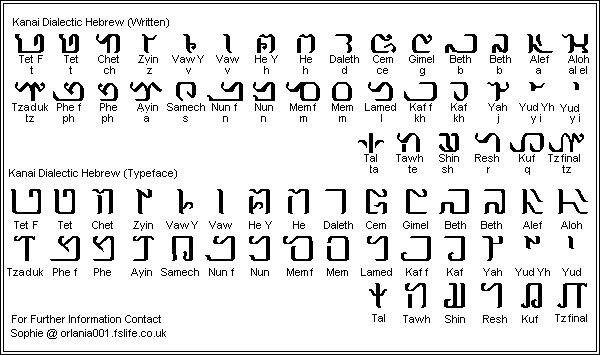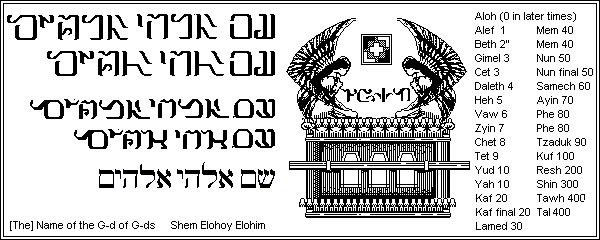This version of the Hebrew script is used mainly in Poland to write an unusual dialect of Hebrew and appears to have come from the Kanai (Zealots).
The mystery of this script is where it originated. The version shown below is the Formal variant as this would be used in certain sacred texts (not the Torah). The text in this formal style was apparently used in a sacred text known as the Shem Elohoy Elohim, which talks about God having 144 names. There are more "finals" in this script and they are often used differently from regular Hebrew. Beth has a "start" this is apparently because the word Bereshyth means "Beginning". This is the word that starts the Torah and the name of the first book, which is Genesis in English.
The Kanai tradition, which was initially "founded" during the Maccaen Revolt, but became more visible during the time of the Herods and Roman occupation of Judea. Famous for Masada when Elizar Ben Yair and his followers commited suicide rather than be captured by the Romans. This was a radical sect of the Kanai tradition called the Sicarii by the Romans.
After the Second Temple Era (536BC-70AD) some still adhereing to this tradition migrated to India and Europe. This Script was apparently used by the European contingent, who refused to use any "Hellenic" language or writing (such as Greek), and were not keen on formal Hebrew in their own texts: they didn't want Pharisees and Sadducees to read their work.
This "not liking the orthodox reading" attitude seems to have continued in Poland where they kept certain writings from the Chassidim, an Ultra Orthodox Sect founded by Israel Ben Eliezar in the 1700s
The script seems to be centered around reverence for the name of God, as the core text was the Shem Elohoy Elohim, refering to the name of God. It is not clear whether any mystical significance was given to the script as the Shem Elohoy Elohim is a series of prayers and commentaries surrounding each name. The Shem Elohoy Elohim is sort of similar to the Qur'an in this respect.
There is a Jewish text, the Shem Ha Mephoresh, which does not read like the Shem Elohoy Elohim but similar names seem to appear. The core difference is that the Shem Ha Mephoresh tends to be about invoking and calling various entities, and does not directly seem to attribute the names to God, rather describes them as "spirits or angels".


Is this script or a derivant of it still in use? Does anyone recognise it? Does the Kanai tradition still survive in India? It was almost obliterated in Europe during the Holocaust. Was there any communication between the Indian Kamaim and the European Kanaim?
If anybody can answer the above questions and/or provide any further information about this script or the dialect it is used to write, please contact Sophia Siedlberg (see above), who provided the information on this page and speaks some of the dialect.
Download a font for this script created by Sophia Siedlberg (TrueType format, 146K)
Bukhori, Hebrew, Judeo-Arabic, Ladino, Yiddish
Page last modified: 23.04.21
[top]
You can support this site by Buying Me A Coffee, and if you like what you see on this page, you can use the buttons below to share it with people you know.

If you like this site and find it useful, you can support it by making a donation via PayPal or Patreon, or by contributing in other ways. Omniglot is how I make my living.
Note: all links on this site to Amazon.com, Amazon.co.uk
and Amazon.fr
are affiliate links. This means I earn a commission if you click on any of them and buy something. So by clicking on these links you can help to support this site.
[top]